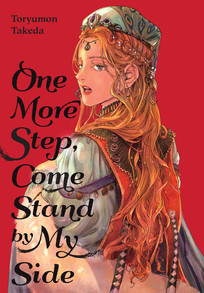Review
by Rebecca Silverman,One More Step, Come Stand by My Side
Manga Review
| Synopsis: |  |
||
In this varied collection of short stories, a princess falls in love with the captor she can't see, a husband tries to cope with his wife's last six months of life, a different princess has plans for the husband she has been handed, and a woman interacts with her stalker, among other small moments in people's lives. One More Step, Come Stand by My Side is translated by Jason Moses and lettered by Chi Bui. |
|||
| Review: | |||
Toryumon Takeda is a relative newcomer to manga, but One More Step, Come Stand by My Side should make us hope she'll stick around for a while. This collection of seven short stories of varying lengths shows a versatile and creative creator. While not all of them make a solid impact, the sheer variety of topics and characters is fascinating. Genres range from slice-of-life to post-apocalyptic, and lengths run from just a few pages to over eighty, making this a good showcase for Takeda and giving readers more than just one author's collection. If you enjoy the craft of the short-form story, that alone is an excellent reason to pick this up. Out of the collection, the first and last stories make the most impact. (That's a pretty solid indication that real thought was put into compiling these pieces since we tend to remember things by how they start and end.) The opening tale, When the Time Comes, is a Middle Eastern-inspired fantasy. It follows a princess who remains unnamed until the very end – she's kidnapped shortly after she comes to power, and withholding her name makes it clear that the kidnappers don't care about her as a person; they just need access to her signature and seal. Kidnapping her is the most expedient way to get those things. She's kept blindfolded during her time with them, and a single guard is in charge of her care. Since she can't see him, the princess recognizes him by his scent and that he is missing his "heart finger," the pinky on his left hand. The guard cares for her kindly, and the young princess – who is around thirteen or so – begins to fall for him, eventually confessing her feelings. The result of this and the truths about her guard don't come to light until she is rescued, and the ending is less romantic and more about how her kidnapping makes the princess reconsider her emotions and circumstances. Although Takeda plays with elements of irony here, those don't feel like the point; instead, the issue is the princess coming to understand and accept her place in the world, and when we finally learn her name, it shows that she has made a decision. Before, she could be anyone. Now, she must be the princess. This use of a person's emotions to find their place in the world is seen in several of the stories in the book. Ten Minutes Later, the Cops Showed Up, the second entry in the collection, is set during the ten-minute interval between when a woman comes home from work to find a strange man in her apartment and when the police show up. The piece is a musing on the woman's part – why the man is stalking her, how she never noticed before, and how she feels about a man being so invested in her that he'd become a stalker in the first place. This one is frankly more uncomfortable than the princess falling in love with her captor because this is a grown woman wondering if she did the right thing and beginning to have second thoughts about it. It's all played as perfectly normal: she's normal, he's normal, and maybe the situation is, too. Like the princess, she never entirely comes to terms with things, but her pondering helps her think about her place in her own life, which may be the most uncomfortable part of the story of all. The Wife Whom I Loved Dearly, which closes out the volume, is the third story to use emotions and the characters' struggles with them, although Nothin' Wrong with That does something similar between two friends. In the former story, a man and his wife find out that she has an aggressive form of cancer with only about six months to live, and they both struggle to find a way to deal with her impending death. Told from his perspective, he tries to cope with the changes he sees in her treatment of him until he finally learns that she's been deliberate about them. The most obviously sad story (although I'd classify all of them as melancholy), it looks at the way love is shaped by tragedy, and it's the most substantial work in the book, although also the most difficult, both to read and to discuss without revealing too much. That holds true for the four-page Ain't That Nice? as well – the lightest in tone in the volume; it's also powerful in how Takeda tells a complete story in so few pages. Still, its brevity means that saying much more is impossible without giving it all away. Suffice it to say it is also a standout. One More Step, Come Stand by My Side is a book best described without sarcasm as "interesting." Takeda's detailed art helps to highlight her versatility when it comes to length and genre, and every story in the book is unique. From fantasy to a darkly amusing take on colonialism, this has a little bit of a lot of things, and fans of seinen manga really shouldn't pass it by. |
| Grade: | |||
|
Overall : B+
Story : B+
Art : A-
+ Richly detailed art, great variety of stories show creator's versatility. |
|||
| Production Info: | ||
|
Full encyclopedia details about |
||